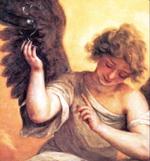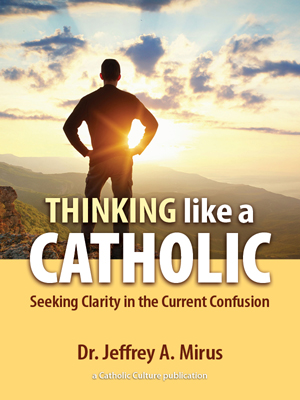Pope Encourages Pilgrimages To Mary's House in Turkey
Rome — An important achievement of Pope John Paul II, though in America it is not well known, is launching what has become a major shrine to the Blessed Virgin, which draws over a million pilgrims a year.
This is the house where our Lady lived with St. John the Evangelist in the city of Ephesus after our Lord's Ascension, until the end of her own earthly life. This is on the coast of the Aegean Sea in what is, at the present time, the nation of Turkey.
In the time of our Lady it was a large and important city, selected by Rome to be the capital of the Roman province of Asia. A modern writer says that Ephesus was the point from which the Apostles first began the spread of Christianity, some years before St. Peter relocated his work of evangelization in Rome.
The modern agreement by scholars on the authenticity of Mary's house is an amazing confirmation of the visions of Anne Catherine Emmerich. The house was altogether unknown to the world until the great visionary described it.
This simple peasant girl who had never attended school was forced to leave the convent she had entered when one of the great French armies unleashed by the anti-Christian revolution swept through the west of Germany. But when she was removed from the seclusion of her convent to live in a private house, her exceptional spiritual gifts, her stigmatic wounds, and her visions became known to devout Catholics.
A well-known writer of the period, Clemens Brentano, became a devout Catholic in the period of renewal and reconstruction of the Church that ensued as the witness of the many holy martyrs began to have its effect. Hearing of this mystic, he visited her and was so convinced by what he saw that he devoted years to taking down what she said about her visions. He remained near her, transcribing her words, until her death at the age of 50 in 1824.
This resulted in due course in the book The Life and Dolorous Passion of our Lord Jesus Christ According to the Visions of Catherine Emmerich.
These are some of her statements dealing with our Lady's last years: "Mary did not live in Ephesus itself but on a hill to the left of the road from Jerusalem.
"It is a very lonely place. John had a house built for her here. It was built of regular stones, rounded at the back. The windows were high up near the flat roof. Mary lived here quietly with her maidservant, a younger woman who fetched what little food they needed. John would visit them when he was not away on his travels.
"A little way behind it was the summit of a hill from which one could see Ephesus and the sea with its many islands."
Despite the edification, which Sr. Emmerich's book brought to many souls, no one seems to have taken it seriously as a source of accurate information about the final period of our Lady's life until 1881.
All this information is taken from a book called Mary's House by Donald Carroll, which I recommend because it appears to be cautious and serious. It was brought out, a few months ago by an English publisher whom I know (Veritas Books, 17 Avenue Mansions, London NW3 7AX — www.veritasbooks.co.uk).
From Carroll's account it appears that no bishops anywhere showed interest in checking whether such a house actually existed — and the Vatican did not take any initiatives, either. But, as I understand the matter, bishops are chiefly concerned with determining that there is nothing opposed to faith or morals in any reported private revelation, and as a rule they have no obligation to promote new revelations even if they are authentic.
There is usually no shortage of persons claiming or promoting new visions and revelations, so that members of the clergy commonly feel that devotees drawn to these things often need scrutiny, even restraint, rather than encouragement.
It does not appear that a copy of Sr. Emmerich's visions reached any of the few Christians in Turkey before 1880. This country was then entirely Islamic, and Istanbul was the center of a great Islamic empire.
There was no question of any kind of modernization, coming to terms with European methods and attitudes that Westerners think of as "progress," the fruit of the Renaissance or the 18th century. The occupation of Islamic Egypt by the French and the English had catastrophic results for that country as Islamic institutions and Western attitudes did not mix.
In 1881 a French priest, Julien Gouyet, went to Ephesus precisely in order to find the house that Catherine Emmerich described, and the local authority, the archbishop of Smyrna (about 50 or 60 miles north of Ephesus) encouraged him. And he found it. At least he found the ruins of an ancient house that closely matched the description in the visions.
But when he returned to Europe we are told, both in France and at the Vatican his superiors discouraged him from making this known to anyone. The uncorroborated witness of one man seemed to them to deserve no credit and to be a potential source of embarrassment.
Ten years later, however, a small group of learned French priests found the Emmerich book and saw the serious value of what she said. In 1891 they organized a small expedition, which satisfied them as to the identity of the little house they found and the one Catherine Emmerich saw. In 1882 they bought the land it stood on from its Turkish owner, to the great delight of the archbishop of Smyrna — the same one who had encouraged Gouyet ten years earlier — as he had all along believed the vision was substantially correct.
Pope Leo XIII became a strong defender of the Virgin Mary's house. In 1902 an apparition of our Lady at the house was reported and miraculous cures were claimed. In 1914 Pope St. Pius X granted a plenary indulgence to those who visited the shrine. Pope Pius XII reconfirmed this indulgence in 1950 after the definition of the dogma of the Assumption, and Blessed Pope John XXIII reconfirmed it again in 1962. In 1967 Pope Paul VI visited the house of our Lady.
But it was the visit by the present Pope in the first year of his reign, when everything he did was news, which dramatically changed the importance, as a Christian pilgrimage, of a place, which till then was virtually unknown to the world. He not only spent time in private prayer in our Lady's house, but celebrated Mass on a raised platform outside it, in front of 2,000 people — at that time a remarkable crowd in this place. He preached to this congregation in French, English, Italian, and Polish.
A local dignitary attended to present gifts to the Pope and to declare that Muslims also pay homage to our Lady. Catholics, Protestants, Muslims, and merely curious visitors have come to the site in greater and greater numbers, especially in the summer months, so that now it has taken on the aspect of another Lourdes. Pilgrims reverently drink the water in a local spring, and there are many crutches, casts, and other memorials of cures and favors displayed in testimony to the gratitude of those who prayed here.
The number of pilgrims each year is considered to be far more than a million — a larger number than perhaps were visiting Lourdes in the years before Vatican II, though far fewer than the five million pilgrims Lourdes was drawing every year by the 1980s.
This item 3473 digitally provided courtesy of CatholicCulture.org






